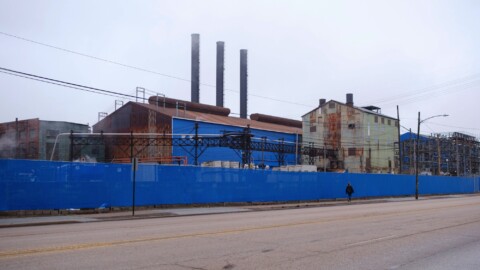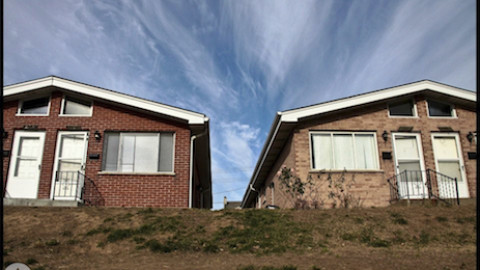photograph by James Palmour
This neighborhood, a transition between St. Louis’ Downtown and the Central West End, is also an important gateway between north St. Louis and south St. Louis. What’s more, it is a transition between a vibrant past and a hopeful future. Covenant Blu/Grand Center was once one of the most important theater districts in the country, and even today, it bills itself as the “cultural soul” of the city (with 12,000 theater seats, 1,500 annual cultural events, 12 museums and galleries, and 1.5 million visitors each year).
photograph by Dan Henrichs Photography, St. Louis
photograph by Allen Casey
photograph by Jason Gray
photograph by Susan Price
photograph by Jim Phillips
With America’s Civil War finally concluded, the invigorating flow of immigrants from Europe returned again to cities like St. Louis. The new swell of residents drove development ever closer to the borders of the newly declared city/county line. However, it would be presumptuous to conclude that the city’s northern, southern, and western neighborhoods grew solely because of another influx of Europeans, when in truth, the reasons for this growth were myriad and much more complex.
During the time of slavery, St. Louis’ enslaved population possessed a skill set much expanded from their plantation-locked peers. This is because slave owners in Mound City often “rented” their slaves to riverboat captains, local business owners, warehouses, and others as a form of cheap labor. In order for this arrangement to work, the slaves needed to live close to the places where they were “employed” (prevailing customs made taking the omnibuses challenging, even for blacks who possessed the required paperwork), and since not all of the urban slave-owners had shelters for their slaves on-site, this meant that African-American neighborhoods sprouted up within walking distance to the lavish neighborhoods of whites. As I am sure many readers will predict, when slavery ended, many of those wealthy whites who had lived in close proximity to black neighborhoods suddenly sought to extend that distance. And so it was, that in the late 1800’s elegant homes began to appear along the new thoroughfare of Grand Avenue (and other places), in an area that would later be known as Grand Center.
photograph by Dan Henrichs Photography, St. Louis
photograph by Allen Casey
photograph by Michelle Bates
photograph by Jason Gray
As a thoroughfare, Grand Avenue is one of the most effective in the city; the street connects Carondelet Park, Tower Grove Park and Fairground Park, but more importantly, it serves as a link between the north side of the city and the south side, with Covenant Blu/Grand Center as the essential terminus. Additionally, and perhaps more significant to the neighborhood’s early development, many of the city’s major east to west corridors (Olive Street, Lindell Boulevard, Delmar Boulevard, Locust Street, and Dr. Martin Luther King Drive) pass through. Even the looming warehouses, industrial buildings, and department stores along Washington Avenue have a route into the neighborhood. By the 1920’s, this vast network supplied Covenant Blu/Grand Center with the distinction of being the major vaudeville and theater district for St. Louis, and its identity as a regional center for arts and culture was well established. Many of the now iconic theaters, including the Fox Theatre and the St. Louis Theatre (now Powell Hall), were built just before the Great Depression as first-run movie palaces. My grandfather, a World War II veteran, recalled hearing about the U.S. declaration of war upon Japan as he and my grandmother emerged from seeing a film at the Fox. The bright burning neon of this dense cluster of movie palaces, vaudevilles, and traditional theaters earned this stretch of Grand Avenue the nickname, “Great White Way”. However, the prosperity and opulence of this generation of Grand Center was not meant to last, and the neighborhood fell into dramatic decline simultaneous to that of the city as a whole.
photograph by Dan Henrichs Photography, St. Louis
photograph by Jeff Phillips
photograph by Susan Price
photograph by Jason Gray
photograph by Dan Henrichs Photography, St. Louis
The 1970’s saw pockets of revitalization efforts emerge in neighborhoods around the city. In the 1980’s, Grand Center saw this trend move to its faded entertainment district. Several nearby institutions, including Saint Louis University (the oldest university west of the Mississippi), Scottish Rite, the Urban League, and more, saw a mixture of economic potential and historically significant buildings worth saving. In this same decade, many of Grand Center’s existing buildings were added to the National Register of Historic Places, and the neighborhood now includes three National Historic Districts. In 1987, Grand Center Inc. was formed and tasked with redeveloping the neighborhood into a center for art and entertainment. Almost thirty years later, the success of this organization has resulted in a list of attractions, including national and regional theaters, museums, galleries, artist studios, performance venues, radio and tv stations, an arts academy, a symphony hall, shops, and dining destinations too long to mention by name.
Certainly, there is still work to do, mostly in the areas furthest away from the intersection of Lindell and Grand, but progress here is a determined and steady march. Grand Center Inc. has even unveiled a plan, titled Growing Grand, that promises to further accelerate economic growth and development in the neighborhood by focusing on support for the arts and enhancements to the public realm (sidewalks, streets, green spaces, etc.). No doubt, the grass is likely greener at the “intersection of art and life”; why not spend some time there and see it for yourself?
photograph by Jason Gray
photograph by Jeff Phillips
photograph by Michelle Bates
photograph by Allen Casey
photograph by James Palmour
Our end point for Photo Flood 29, was the fantastic new Lucha, a “Mexican Soul Food Restaurant”. PFSTL favorites included burritos and hand-made margaritas (are you hungry yet?), but the young restaurant has already gained a reputation for various other excellent offerings as well. Note: Lucha does not currently accept reservations, so be sure to time your visits around the activities of the theaters and the symphony.
photograph by Dan Henrichs Photography, St. Louis































[…] for Independent Media and the Station’s future headquarters. This structure, located in Covenant Blu/Grand Center, will be home to a cafe, a music venue, and a recording studio, as well as, broadcasting booths and […]
[…] the early 1900’s, the area now known as Grand Center was founded as the city’s premier theater and movie-house district, […]